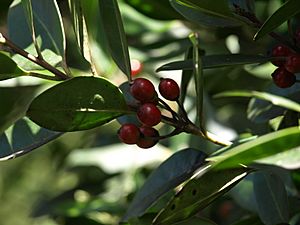Small-leaved holly facts for kids
Quick facts for kids Small-leaved holly |
|
|---|---|
 |
|
| Conservation status | |
| Scientific classification | |
| Genus: |
Ilex
|
| Species: |
canariensis
|
The small-leaved holly, known scientifically as Ilex canariensis, is a special type of holly plant. It grows naturally only on the Macaronesian islands, which include Madeira (part of Portugal) and the Canary Islands (part of Spain). This plant belongs to the Aquifoliaceae family, just like other holly plants.
Contents
What is the Small-Leaved Holly?
This unique plant is called acebiño in Spanish and azevinho in Portuguese. It usually grows as a shrub or a small tree. It can reach about 6.5 meters (around 21 feet) tall, and sometimes even up to 10 meters (about 33 feet)!
Appearance of the Small-Leaved Holly
The small-leaved holly is an evergreen plant, meaning its leaves stay green all year round. It has a gray trunk. Its leaves are shiny and shaped like an oval. They are usually about 5 to 7 centimeters (2 to 3 inches) long and 2.5 to 4 centimeters (1 to 1.5 inches) wide. Unlike some other hollies, its leaves usually have smooth, rounded edges with only a few small spines. However, younger leaves can sometimes be more spiky.
Flowers and Fruits
The small-leaved holly produces tiny white flowers. These flowers grow in small groups where the leaves meet the stem. It usually blooms from May to June.
After the flowers, the plant grows round, red fruits. These fruits are about 1 centimeter (less than half an inch) wide and look like small, fleshy red berries. They grow on short stems that are about 3 to 8 millimeters long. There are two slightly different types, or subspecies, of this plant. One subspecies, called ssp. azevinho, can have berries that are a bit larger, up to 2 centimeters (almost an inch) wide.
Where Does the Small-Leaved Holly Live?
Ilex canariensis is closely related to the European holly. It is an endemic species, which means it is found only in the Madeira and Canary Islands. Both subspecies of this plant have light-colored trunks with white and brown spots.
Habitat and Environment
This plant thrives in places with high humidity and mild, steady temperatures. You can mostly find it in laurisilva forests or in damp areas like the bottom of ravines. Laurisilva forests are subtropical forests that are very humid and have stable, mild temperatures. The laurisilva forests in Macaronesia are special because they have many unique trees, and the small-leaved holly is one of them.
Why is it Threatened?
The small-leaved holly is currently threatened by habitat loss. This means that the places where it naturally grows are shrinking. Even though laurisilva forests might be growing in some areas like Madeira, other parts of its range face challenges. For example, grazing animals like sheep and goats can eat the plants, and fires can destroy their habitat.
Interestingly, this holly has lost most of the spines that European hollies have on their leaves. Scientists believe this happened because there were no large plant-eating animals on these islands until humans brought cattle. Without the need to protect themselves from grazing, the spines became less common over time.
Images for kids
See also
 In Spanish: Acebiño para niños
In Spanish: Acebiño para niños



